|
 Bison Year In Ukraine
Bison Year In Ukraine
“It is true, that the north is inhabited
by wisents. They are fat, tameless and extremely fierce.
Wisents hate humanity, because many of them (people) hunt
them for food. They have citreous fur. In front they have
spreading exhibitive horns, helpful in fights and everyday
life.”
«About Sarmathia, European region», Shedel G., XV century.
«How, do we have wisents remained?
Why nothing is heard, that’s a real value…»
Reply of a zoologist on the data of dramatic decrease
of bison livestock on the territory of Ukraine.
Introduction
Dear reader! Coalition of environmental
organizations of Ukraine, Ukrainian Theriological School,
supported by the Ministry of Environmental Protection
of Ukraine, have proclaimed year 2009 the year of the
wisent. Why wisent? This article gives the answer. There
is no doubt that you have heard about European bison and
could imagine the appearance of this magnificent, precious
animal, real lord of ancient European forests. The bison
images could be seen on the plenty of emblems, trade marks
and other symbols. Bison is the only representative of
the wild bulls which has been living on the territory
of Europe since the Pliocene age.
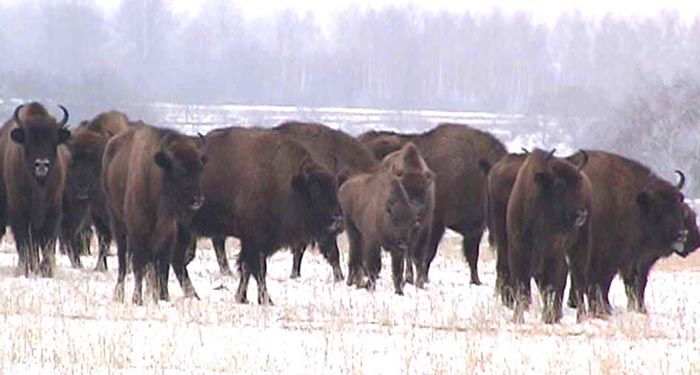
Photo 1. Wisents gather in herds reaching
amount of dozens of heads
However, this unique animal was already
more than once under threat of extinction. In 1927 wisents
completely disappeared in nature, and only 52 specimens
were saved in different zoos. Thanks to enormous efforts,
this population of wisents was successfully restored and
returned to the former habitats. According to its vulnerability,
wisent is protected by the International Red Book, European
Red List, Bern Convention (Appendix III), Red Book of
Ukraine, and also by Red Books and Lists of neighboring
countries: Russia, Poland, Belarus, Lithuania. On January
2007 there were 730 wisents in Belarus, 380 individuals
in Russia (350 Caucasian European bisons which have admixtures
of American bison’s blood are not taken into account),
and near 900 individuals in Poland.
However, in some other countries European
bison destiny is quite different. In particular, Bulgarian
population is almost completely exterminated. We can see
abrupt decline of Ukrainian bisons population quantity:
685 individuals in 1992, in 1995 there were 659 heads,
in 2000 – 405 heads, in 2004 – 325 heads, in 2005 – 303
heads. By the state on 2007 there were already less than
255 bisons in Ukraine – bison’s quantity has fallen down
in three times for the last 15 years. So, Ukrainian bison
is steadily moving to its extinction. Could it be staved
off?
Bison extinction on the territory
of Ukraine
In historical time bison was the ordinary
species of Ukraine and inhabited greater part of its territory
to the coasts of Black and Azov Sea, including the Crimean
peninsula. History of this animal in Ukraine, like in
Europe on the whole, is a story of permanent persecution,
which had to lead to the tragic final. In ancient Russian
chronicles bisons are not mentioned, while references
about another wild bull – aurochs – are numerous. However,
such situation is explained by scientists in the way that
these two bulls simply were not distinguished by ancient
chroniclers. In spite of deep respect wisent and aurochs
force evoked, they were regarded entirely as hunting animal.
Simply saying, they were a source of meet and hunting
entertainment. It is known that huge amount of these animals
were killed for troops food supply. For example, lots
of wisent bulk were provided for Lithuanian-Polish forces
intending to Gruenwald battle in 1410 year.
Gradually bison became rare species and
a beast exclusively for elite hunting. So, in the Belarusian
medieval cities bison’s remains happen mainly on castle
territories.
It is considered that two subspecieses
lived on the territory of Ukraine: bialowezian lowland
form and mountain Carpathian form. As for bialowezian
form, in XVI-XVII century it was probably widespread from
Dniester River to Don River, forming large herds in Podolia.
Bisons amounted considerable quantity on territory of
the Kyiv province. The last information about bison’s
encounter at forest-steppe and steppe zone could is dated
to the second half of the XVIII century, when they were
in Podolia and Black Sea steppes. However, at the end
of XVIII century bison disappeared from the steppe and
forest-steppe areas of Ukraine. The exact date of disappearance
of bisons in Ukrainian Polesia is not specified, but they
disappeared on this territory not later than the end of
the XVIII century.
It is known from the 1717 records of Kantemir
that Carpathian form of bison lived till the beginning
of the XVII century. Turanin in 1972 marks that the last
wisent in Marmarosh Carpathians was killed in 1814 year,
but this report still remains unfounded. More concrete
information is that the last wisent in Carpathians was
shot in 1762. Moreover, it is specified that general disappearance
of mountain subspecies was in 1790. The Romanian sources
testify that on Bukovyna bisons were present until the
beginning of ХІХ century. Nevertheless, not later than
up to the beginning of XIX century the honor of aboriginal
European fauna – European bison – had extincted on our
lands. It is worth saying that bison extermination was
insistently conducted in other European countries as well:
bison extinction on the Sweden territory took place in
XI century. Interestingly, that historical memory of this
nation did not hold no notion about bison appearance;
therefore, when it was reintroduced to the fauna of this
country, it was considered by indigenous people to be
exotic animal. Not later than in XVI century bison was
totally exterminated in Central Europe, and in XVII century
also on the majority of flatlands of Eastern Europe. In
that way, Bialowezian Forests and Carpathian Mountains
had remained the last habitats of this animal until remorseless
arm of the hunter finished its black deed. Symbolically,
at another corner of the globe the same cruel arm had
almost completed the extermination of wisent’s nearest
relative – American bison.
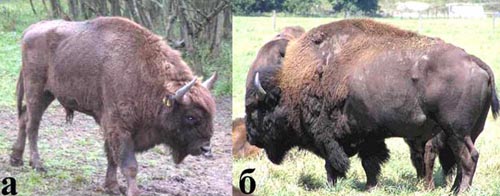
Photo 2. Despite having evident morphological
differences, European (a) and American (b) bisons are
very close species, able to intercross freely with each
other giving fertile progeny. That’s why they were believed
by some scientists to be the same species.
Brief history of wisent restoration
in Ukraine
However, bison didn’t extinct finally on
the planet, as it happened, for instance, to aurochs or
wild horse – tarpan, widespread animals, which contributed
many years ago to stability of forest and forest-steppe
ecosystems in Europe. The first attempts to restore wisent
in Ukraine were done before the revolution, when the last
bison herd in wild still existed on the territory of Bialowezian
Forest. Thus, in the hunting park of Count Jozef Potocki
“Pylyavyn” (Novograd Volyn district of Zhitomir region)
lowland subspecies of wisents from Bialowieza Forest along
with the American bison specimens were imported. Besides,
in winter 1913 thoroughbred bialowezian wisents (1 male
and 3 females) were brought in enclosure of “Crimean Royal
Hunt” (in present it's Crimean reserve), but animals felt
badly and began to lose weight, so they were released
in 1914. By 1917 there were 9 heads. Both groups of wisents
died in the revolutionary events.
The first attempts to restore wisent in
Ukraine were before the revolution. Thus, in the hunting
park of Count Jozef Potocki “Pylyavyn” (Novograd Volyn
district of Zhitomir region) lowland subspecies of wisents
from Bialowieza Forest along with the American bison specimens
were imported. Besides, in winter 1913 thoroughbred bialowezian
wisents (1 male and 3 females) were brought in enclosure
of “Crimean Royal Hunt” (in present it's Crimean reserve),
but animals felt badly and began to lose weight, so they
were released in 1914. By 1917 there were 9 heads. Both
groups of wisents died in the revolutionary events.
Subsequent attempts to restore bison concerned
works based on the hybridization with American bisons
that were conducted in Askania Nova and recurring import
of individuals in 1937 to present Crimean reserve. In
1941 the herd of hybrids contained more than 14 heads;
however, during the war-time it was exterminated by invaders
and partisans.
After complete death of free living bialowezian
wisents during the First World War, in 1923 in Frankfurt
am Main the International Society for Protection of European
Bison was created. Species was reproduced on the basis
of 54 zoo individuals, which originated from 12 animals-founders.
In post-war years in the Soviet part of the Bialowieza
Forest, a nursery was built for breeding of thoroughbred
bisons received from Poland. They were represented by
two genetic lines: Bialowieza (lowland) and Bialowieza-Caucasian
(with admixture of blood from a single representative
of the Caucasian subspecies - bull named Kaukasus). Afterwards
a decision was accepted about maintenance on territory
of the Bialowieza Forest exceptionally bialowezian line
of bisons; all representatives of Bialowieza-Caucasian
lines were removed. Because of the fact that territory
of Ukraine belongs to the natural habitat of bisons, since
1965 systematic work was begun on creation here a free
living population. Bialowieza nursery was located too
close to the border. In the central districts of Russia
the new Prioksko-Terasny and Okskiy wisent nurseries are
created. Animals from these breeding centres were actively
settled in different places of Ukraine. Bison’s groups
were created in L’viv, Rivne, Volyn, Kyiv, Chernivtsi
regions of Ukraine. Unsuccessful attempt was made on restoration
of wisents in Crimea. Left on the north slopes of the
Crimean Mountains in Bakhchisaray district, the wisents
caused numerous conflicts, so in 1980 these animals (20
heads) were evacuated in the Chernihiv region. In 1976-1986
new populations were created in Ivano-Frankivs’k, Vinnitsia,
L’viv (Lopatyn population), and Sumy regions. Expansion
of wisents also took place on the territory of Khmelnitski
region. Thus, at the beginning of 1990th the quantity
of wisent steadily increased. All free living Ukrainian
populations consisted from Bialowieza-Caucasian line of
wisents. An exception was Lopatyn population, situated
on the territory of state hunting husbandry “Styr” in
Radehiv district of L’viv region.
How do you do, Ukrainian bison?
After relatively secure Soviet times, at
the end of 1990th the number of wisent’s populations began
to decline rapidly. Afterwards populations fully disappeared
in Ivano-Frankivsk (Nadvirnyanska population), Rivne (on
territory of Klevanske hunting husbandry), and Khmel'nytskiy
regions (group of individuals of Volyn subpopulation which
migrated from Tsumanska forest). However, thorough investigation
of this adverse event was not conducted. Therefore, further
development of this trend led to a sharp reduction of
quantity of two major Uladivska and Bukovinska populations,
and decline of Tsumanska population of Volyn region to
the limits of its survival. Also we should recognize the
full loss of Daniv population in Chernihiv region the
real tragedy of recent years.
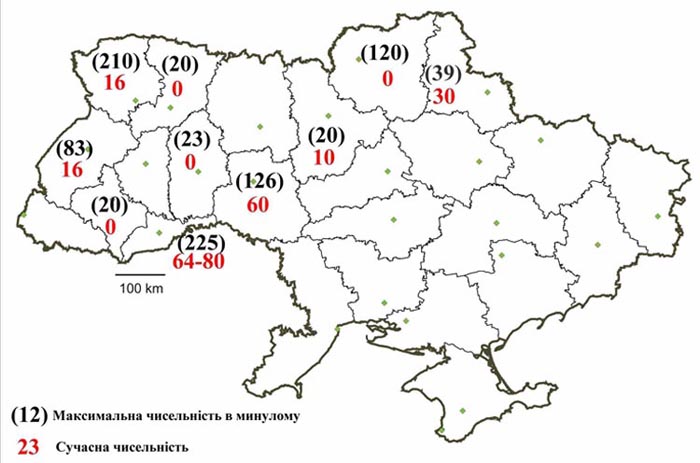
Photo 3. Dynamics of quantity of bison
populations in regions of Ukraine
On the 1st of January, 2008, an amount
of Ukrainian bisons according to official data was 258
heads, whereas results of independent investigations showed
figures of not more than 190-230 heads.
Causes of dramatic reduction of
wisent populations in Ukraine
The existing situation in Ukraine is explained
by termination of the state attention to the issue of
wisent preservation, prosperity of poaching, and also
commercial hunting for wisents under the guise of selective
shooting, which was organized by State Committee of Forestry
of Ukraine.
In all neighbouring countries, where the
population of wisents increases, the government programs
are conducted for wisent protection. These programs are
financed from the state budget or extra budgetary funds.
For example, in Poland the state program “Land of wisent”
has been implemented since 2003 year. For this initiative
from the funds of European Union 956 thousand euros are
allocated. In Russia in 1997 the Interregional Program
for wisent preservation was approved; in 1998 the Working
Group on the wisents was established, and this group adopted
the «Wisent conservation strategy in Russia». In Belarus
“The State program on resettlement, conservation and use
of wisents in Belarus” were approved in 1998. In Ukraine,
only one joint decree is developed by the Ministry of
Environmental Protection and State Committee of Forestry
of Ukraine “On approval of the Plan of Action for the
conservation of wisents in fauna of Ukraine”. But this
plan can not be described as administrative and practical
document, as it does not include specific implementation
dates, specific executors; the document also doesn't provide
any funding (>>>).
In addition, the development of State financed program
for wisent protection finds no support in the Ministry
of Environmental Protection.
The wisent is a desirable and fashionable
trophy for wealthy hunters. In fact, wisent is not protected
from poachers neither by severe penalties (up to 1700
UAH), reimbursement (up to 2500 UAH), nor by imprisonment
for up to three years. Indeed, poaching remains completely
unpunished. A separate issue is also a complete lack of
wisent protection outside forest lands.
One of the reasons for the rapid reduction
of the wisents’ is selective shooting, which is not mentioned
in official overviews (>>>).
Article 19 of the Law of Ukraine “About the Red Book of
Ukraine” allows, as an exception, getting Red Book species
for breeding and scientific purpose. Instruction on the
selective shooting of game animals, approved by State
Committee of Forestry of Ukraine, determines that “selective
shooting is conducted in the case of the sick, injured
animals, old animals with clear signs of degradation,
underdeveloped two-years-old young animals, animals with
uncharacteristic colour... Shooting of healthy animals,
which have no clear anomalies in their structure, is categorically
prohibited”. All decisions regarding the selective
shooting must be agreed with the Commission of the Red
Book. However, the first such agreement was given only
in 2007, so during all this time such shooting has been
committed illegally. In addition, it was found that since
2000 the Committee of Veterinary Medicine has not issued
any permission for the export of wisent trophies.
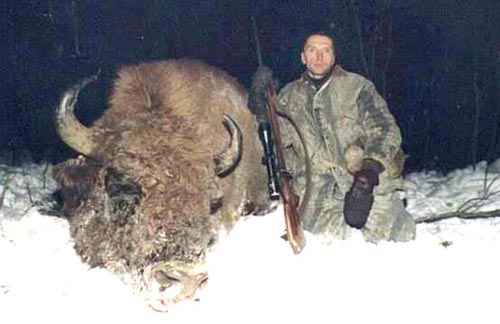
Photo 4. Russian businessman Andreev with
bison shot by him
Shooting of rare animals for profit attained
its culmination after 2002, when State Committee of Forestry
accepted an order «About the statement of boundary levels
of prices on hunting trophies, which are obtained by foreign
citizens, and boundary levels of tariffs on services,
which they get». This document defined payment on services
of commercial hunting on two species of animals listed
in the Red Book of Ukraine: the bear and the wisent. According
to this price list for shooting a bear a foreigner had
to pay 2600-3100 UAH, for getting trophy wisent, which
obtains a gold medal by the assessment of CIC, - 3100-3600
UAH, silver medal - 2600-3100 UAH, bronze medal - 2100
- 2600 UAH, for killing female wisent - 1100-1300 UAH,
and young animal - 800-1100 UAH (
www.svshunt.com). You can watch the shocking video
of wisent hunting on
www.youtube.com/watch?v=5w7FoRm3dGM.
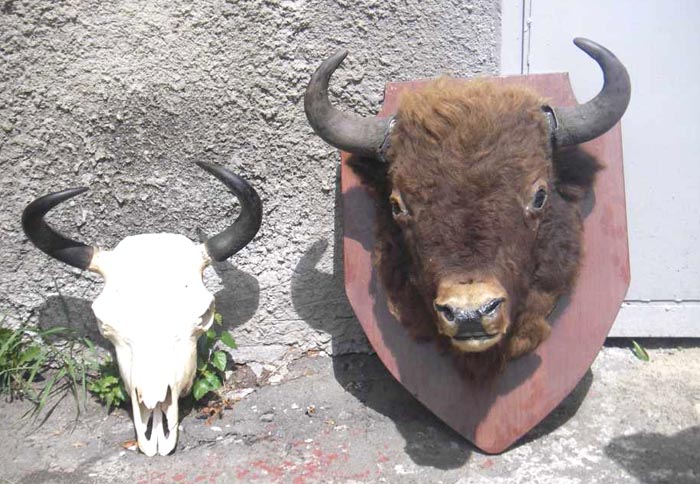
Photo 5. Unregistered “trophies” in the
garage of Khmel’nytsky forestry
Besides, the Ministry of Environmental
Protection has issued a «Regulations on the order of accounting,
certification and issuance of permits for the relocation,
getting (capture, shooting) wisents for selection» dated
by the 19 of December 1991. This document was used only
to attract foreign hunters for «selective shooting» of
wisent, take payments and use killed wisent as a trophy.
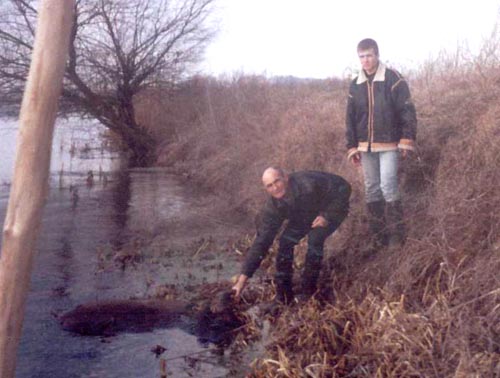
Photo 6. In 1990-th Danivka subpopulation
(Chernihiv district) numbered more than 100 bisons. Nevertheless,
they were steadily shooted, and the meat was carved on
the Nizhyn meat-packing plant. The last Chernihiv wisents
were bayed with cars to the Oster River, where they faced
their death
Causes of the dramatic reduction
of wisent populations in Ukraine
It should be noted that the selective shooting
of specimens incapable in reproduction, or those who have
signs of genetic degeneration consistently applied in
Poland and Belarus.
But in these cases only tagged for selection
wisents are killed. Indeed, the wisents with disabilities
may sometimes have good horn as a trophy; this in turn
allows organizing hunting for wealthy people, as it happens
in Boretsky Forest. Obtained funds are forwarded for support
wisents breeding and purchase of additional forage for
these animals. Quality of infrastructure for breeding
wisents in Poland convinces that it is really so.
However, unlike Poland, in Ukraine hunting
for selection was only a cover for the shooting of any
desired wisent that brought substantial profits to organizers
of such hunting. Decline of cultivation and resettlement
of wisents confirms such state of affairs.
Characteristic of the modern state
of wisent populations in Ukraine
Thus, currently wisents survived only in
Sumy, Kyiv, Vinnytsia, Volyn, Lviv and Chernivtsi regions.
The inventory of their livestock was performed at the
request of environmental public organizations; the results
show relatively low percentage of young animals among
overall population and dominance of females over males.
On the whole, wisents males are more vulnerable to diseases
including those associated with the consequences of inbreeding
depression. Under conditions when the balanoposthitis
was distributed only in one group of Ukrainian wisents
(Naddvirnyanska subpopulation), which is now fully eliminated,
this gender imbalance evidences about the consequences
of VIP-poaching, which was realized under the guise of
selective shooting, because its targets are primarily
males with trophy qualities horns.
Despite of weakening of wisent modern populations
they are represented in most of the natural zones of Ukraine:
Polissia, Carpathian Mountains and forest-steppe natural
zones, and serve as good source material for further wisent
husbandry, fitted to these natural areas. Bukovynska population
and population of National park «Skolivski Beskydy» are
very promising for the creation of large transboundary
herds of wisent in cooperation with Romania, Poland and
Slovakia. Bukovynska population is very valuable for solving
the problem of lowland wisents’ adaptation to extreme
mountain environment; it can provide adapted to mountain
conditions wisents for settling them in other areas of
Carpathians.
Currently wisents’ populations in Ukraine
live in quite large woodlands, which are represented mainly
by mixed coniferous-deciduous forests with varying degrees
of economic exploitation. Along with forest there are
meadow ecosystems and agrocenosis in most areas, which
have great importance for the survival of wisents’ populations
in the winter time.
Because the majority of wisent groups live
on the territories of hunting husbandries, in winter they
can get additional forage, which is prepared mainly for
maintenance of other game animals.
During the end of 2008 and beginning of
2009 animals of Bialowezska-Caucasian line were imported
in location of Lopatinska group that was the last residence
of Bialowezska genetic line of wisents in Ukraine. It
was a planned measure according to the Action Plan for
Ukrainian wisents’ conservation. Moreover, 6 animals originated
from Germany were imported to National Park “Skolivs’ky
Beskydy” in June, 2009.
Protection of wisent habitats in
Ukraine
Currently wisents are protected only in
the National Park «Skolivski Beskydy» (Lvyv region, area
is 35 684 hectares), and in local reserves «Zubr» (Volyn
region, area is 2 732 hectares) and «Zubrovytsya» (Chernivtsi
region, area is 11 700 hectares). Wisents live on the
territory of State hunting husbandry “Styr” within Lahodivske
and Zabolotsivske Forestry, and occupy territory of the
total area of 9 thousand 563 hectares. Pathways of movement
and location of the wisents go through protected areas
«Lahodivske» (6,2 ha), «Zabolotsivske» (46,2 ha), and
partly through botanical reserve «Kempa» (10 ha) and hydrological
reserve «Ponykivsky», total area of 112,1 ha. Konotopska
wisents population is situated in existing regional landscape
park (projected National Park) «Serednoseymsky», total
area of 53 400 hectares. State residence «Zalissia», which
is the location of semi-free living wisents group, is
planned to be transformed into a national park.
Condition of wisent breeding in
Ukrainian zoos
The semi-free living Ukrainian wisents
are held only in state residence «Zalissia» and in zoos.
Unfortunately not in all zoos of Ukraine there are conditions
for successful reproduction of wisents; animals are often
presented in the exhibition by single old specimens.
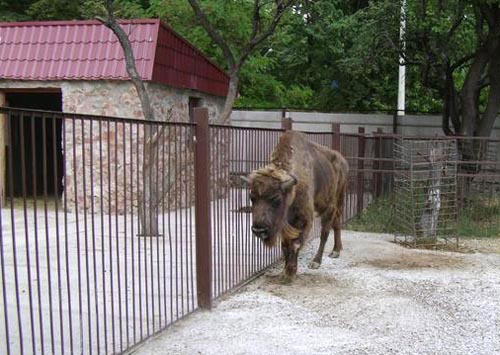
Photo 7. Lone wisent in the Simpheropol
menagerie
Survey in Ukrainian zoos showed that the
issue of wisent procreator acquisition remains very difficult.
It is almost unreal to receive the permit for capturing
wisents for zoo, contrasting with receiving a permit for
selective shooting. In this situation it is much easier
to buy American bisons. As a result, one of the largest
zoos in Ukraine – Kharkiv zoo – doesn’t have wisents at
all, and breeds only American bisons. Another difficulty
in wisents’ keeping is necessity to supply them with woody
forage, whereas herbaceous feed is enough for American
bisons.
Accordingly, nowadays only two zoos have
propagable wisents; meanwhile wisents in the Vinnytsa
zoo have their origin in Kyiv zoo. All this bisons originated
from Pryoksko-Terasny nursery and belong to Bialowezian-Caucasian
line. The first wisents’ breed was got in the Kyiv zoo
in 1973.
In addition, in Ukrainian zoos quality
of life of wisents is not good. Indeed, because of carelessness
of zoo management, some of wisents have starved to death,
such as in the case of pregnant female in Cherkasy zoo.
Wisent in Ukrainian culture
Wisent is essential part of world of nature,
which encompassed ancient slavonian living on the territory
of Kievian Rus. These powerful creatures are mentioned
on the pages of novels dedicated to this period of our
history. Impressive is the description of wisents herd
moving through misty morning forest in the novel “Miracle”
by Pavlo Zahrebelny. Later bisons were those animals which
surrounded steppe Cossacks fighting for freedom. Javornytsky,
a chronicler of Zaporiz’ka Sich, mentions them as praerian
bulls.
On the territory of L’viv region river
Zubra flows (ukr. “zubr”=wisent). There are also a village
in Pustomyliv district of L’viv region and an amenity
forest in L’viv which are named after this river.
During Soviet age wisent was one of the
main symbols of nature conservation; its image could be
found almost in all books and leaflets dedicated to protection
of nature of Ukrainian SSR. There are bison monuments
in Ukraine; for instance, a figure of this animal is located
near the Kyiv zoo entrance.
Zoological conferences often choose bison
as their emblems. Specifically, Yong Zoologists’ Conference
which took place in 2009 had a bison mage on its emblem.
With the patronage movement development in Kyiv Zoo, large
animals became the first candidates for wardship; particularly,
bison felt under the patronage of the first assistant
of Kyiv Council Head.
Zubra Village Council has adopted the emblem
of the village which portrays a red bison on a yellow
background of the square width, facing a shaft. A blue
horizontal stripe occupies the one forth of the flag height
on the top. The emblem was designed by A. Grechilo.
|
|
Photo 8. An emblem
of the Zubra village (L’viv region) |
Рhoto 9. A silver
coin with the wisent image |
In 2003 The National Bank of Ukraine emitted
silver coins designed by Volodymyr Demyanenko with face
value 2 and 10 Ukrainian hryvnas with bison image.
Among local people attitude towards bisons
alters from antagonistic, as the large animal harmful
and can damage agriculture lands, to positive – some indigenous
enthusiasts really worship wisent as a treasure of nature
of Ukrainian regions.
Horrifying bloom of poaching and trophy
hunting is a convincing evidence that the general attitude
of Ukrainians towards this animal did not notably changed
from the Medieval Age, when it was regarded as the hunting
target and the source of large portion of meat.
Measures for improving the situation
On the whole, 1990th and 2000th have been
extremely harsh for the population of wisents. At that
time Ukraine has finally lost the leadership in quantity
of this rare animal. The rest of free living subpopulations
have imbalanced gender structure, and can not survive
without human intervention. Basing on this bad situation
we can conclude that raise of the attention of scientists
and the public to the population of wisents is essential.
In this case, it will be better to follow the experience
of modern Poland, which has the largest population of
this animal in the world. Measures for recovery of wisents
should base on scientific researches, law reforms, search
of financial support, and educational activities. They
fall into such categories:
Scientific researches.
Important task is to create a scientific
group of zoologists, zoo workers, representatives of public
organizations, which are engaged in work with wisents,
and the regional offices of environmental protection.
Such research group may exist within the Commission of
the Red Book in close cooperation with the Ministry of
Environmental Protection. This group should enter into
contact with European Bison Friends Society. Its primary
tasks are careful inventory of all semi-free and free
subpopulations of wisents with defined origin, and transmission
of these data for the European bison pedigree book.
Efforts also should be aimed at identifying
locations suitable for creating free-living wisents populations.
This species, as evidenced by research, is unpretentious
enough to the conditions of existence; wisents inhabit
a wide range of mixed-forests that alternate with open
stations and have a good source of drinking water. Separately,
the capacity of land, availability of food and amount
of required additional forage should be studied. The best
locations are in remote places with underdeveloped network
of settlements. Also conditions for the creation of transboundary
livestock should be studied that will make possible creation
of several large herds numbering not less than 1000 heads,
which will guarantee long-term survival of species.
Wisents have passed through the effect
of population bottleneck, so they are very vulnerable
to diseases. This situation obliges to be ready to contend
against outbreaks of certain diseases. So, recently in
German in wisent breeding nursery Hardihauzen in a short
period 10 wisent died from the outbreak of bluetongue
disease. Taking into account this threat, veterinary control
for wisents’ populations must be introduced with involvement
of scientific veterinary institutions of Ukraine.
Legal measures.
It is required to increase protection category
of wisent in Red Book of Ukraine to the second category
- vulnerable species, which in the near future may be
classified as «endangered», if the effect of factors affecting
the population does not stop. The up-to-day question is
creation of legal mechanism for civil compensation of
loss in agriculture caused by wisents (crop damage, destruction
of fences, etc.) and state aid as forage for additional
feeding to those farmers who hold wisents. At the same
time this forage can be used by other hunting animals
that create benefits for hunting husbandries which hold
wisents. It is expedient to add an item on the protection
of wisents to the decree of the Cabinet of Ministers of
Ukraine «On the list of activities related to environmental
measures» (September 17, 1996 № 1147) that will allow
more easily allocate funds from regional environmental
funds at various events (additional feeding, relocation,
etc.) for wisents’ protection.
Organizational measures.
Currently in Ukraine there are no financed
long-term state programs related to a whole wisent population.
There are only joint document of the Ministry of Environmental
Protection and State Committee of Forestry of Ukraine
«Program of European bison (wisent) reintroduction in
the Skole Beskydy (Ukrainian Carpathians) until 2015»,
which was approved on 25 of October 2007.
In addition, under the influence of environmental
organisations, according to the plan of environmental
protection, from the budgetary programme of the Fund for
Environmental Protection «Formation of National Ecological
Network» until 2011 provided the research theme «Certification
of subpopulations and development of plan for the wisent
resettlement in Ukraine based on the current state, the
feeding base and optimum quantity; development and implementation
of measures for its preservation, including informational
and educational actions». Executor of the theme with budget
of 840 000 UAH is the Shmalhausen Institute of Zoology
NAS of Ukraine. However, it is clear that one such event
is not enough. Undoubtedly, it is necessary to adopt the
experience of neighbouring countries and develop and approve
the state program for protection and breeding of wisent
that would include the concrete and financed constant
current protection strategy (the description of measures
planned within the project could be found on lesovod.org.ua).
It’s clear that the formation and implementation of such
programs is not one year aim, but we must start now.
Significant efficiency also demonstrates
the creation of public funds and involvement of environmental
non-governmental organizations and media for wisents’
protection. (description of one of them “Let serve European
Bison" see in: >>>).
Current situation in forestry and hunting
economy requires the creation of new or relocation of
existing populations of wisents from hunting husbandries
(which are not interested in their protection) to reserves
and national parks. It’s needed to promote actively the
creation of new nature reserves in wisents’ habitats,
including national park “Tsumanska Pushcha” in Volyn region,
national park “Serednoseymsky” in Sumy region, special
reserves for wisents in Vinnytsya forestry and hunting
husbandry "Styr", and provide expansion of existing
protected areas: reserve “Zubrovytsya” in Chernivci region
and “Zubr” in Volyn region, which is still sabotaged by
foresters (>>>).
Due to considerable problems related to
process of bison importing from abroad, it is time for
creation of bison nursery similar to the one in Pryoksko-Terasnyj
reserve. The best place for it seems to be on the territory
of the future National Park “Zalissia” or Regional Landscape
Park “Mezhyrichensky”.
It is necessary to solve the question on
the transfer of wisents to Ukrainian zoos, which have
a desire to breed wisents, in case that they will provide
offsprings for resettlement and replenishment of existing
populations. Thus, some of zoos can be converted to additional
nurseries for wisents. The issue of equal importance is
to renew wisent breeding in the steppe zone on the basis
of zoo in biosphere reserve “Askaniya Nova”.
An important matter for the security of
wisents in the fauna of Ukraine is creation of several
large base populations of wisents having 500-1000 heads
in each. Areas for wisents’ dwelling are available in
transboundary territories of Ukraine, Russia, Belarus,
Poland, Slovakia and Romania.
Operational measures.
Efforts should be aimed at improving combat
with poaching as the main threat for wisents. In some
way this issue proceeds to creation of new wisents’ groups
on the territories of national parks and nature reserves,
which can allow using capabilities of existing guard groups
for wisents’ protection. Ideal situation will be to create
well-equipped specialized units for the protection of
wisents. No less important is the investigation of all
cases of poaching for the wisents, bringing offenders
to account, and publication results in the press.
Propaganda and educational activities
Propaganda and educational activities are
not less important in fight for Ukrainian wisents’ protection,
because changing attitude of Ukrainians to the wisents
as harmful animals or hunting trophy on the idea of it
as a living memorial of Kievan Rus requires considerable
investments and efforts. Changing the attitude of local
people to the wisents, explaining the necessity and features
of the restoration of wisents populations should be done
by developing and implementing educational programs for
students in areas of wisents’ residence, and wide propaganda
through Ukrainian public hunting organizations and hunting
magazines. Organization of large campaigns in the media
shows its high efficiency. An effective measure could
be adopting Polish experience in creation of «Park of
wisents» (where they are in semi-free conditions) for
environmental education and monitoring for students and
tourists. Wisents, which are culled from natural livestock,
should be captured for such parks. It’s necessary to develop
and implement programs for attraction of socially oriented
business. For example, the Russian office of WWF implemented
program “Adopt wisent” and “Wisent under good protection”.
It will be interesting to approve medal for the protection
of wisents, similar to experience of Poland, which is
awarded the Medal “Friend of wisent”. Currently coalition
of Ukrainian environmental organizations, together with
the Ukrainian Theriological School, under support of the
Ministry of Environmental Protection, announced 2009 year
in Ukraine - The Year of Wisent (pryroda.in.ua/dop-kyiv/2009-–-rik-zubra-v-ukraїni).
Also thematic speeches are planned on environmental and
scientific conferences to draw attention to questions
of protection of the patriarch of Ukrainian forests -
wisents.
Conclusions
Wisent is not only an integral component
of the fauna of Ukraine, which return the ecosystem closer
to original form, but also a real symbol of wild nature,
which requires special and careful approach to conservation
and reproduction.
In Ukraine, wisents came under threat of
extinction not due to some natural causes related to its
biology or availability of suitable habitats, but because
of uncontrolled poaching and savage commercial shooting.
Restoration of wisents’ populations in
Ukraine first of all requires the formation, approval
and implementation of programs provided with targeted
budgetary funds.
Let’s remember, that humankind is branded
for almost complete fact of wisent extermination. That’s
why restoration of its population and everlasting care
have to be the only way to wipe off this deep disgrace.
Kyiv Ecology & Culture Centre
Biodiversity Conservation and Protected Areas Coordinator
Ivan Parnikoza
translation: Ksenia Tugolukova (Kyiv-Mohyla
Academy), html-version: Igor Zagorodniuk
See also:
1. www.chornobyl.net/ua/index.php?newsid=1228144839
2. http://www.volynnews.com/news/government/6141/
3. www.tehnichka.com/index.php?option=com_content&task=view&id=1288&Itemid=75
4. h.ua/story/24124/
Ukrainian version of "Bison page"
in this site >>>
created 22.06.2009; updated 29.07.2009
повернутися
на сторінку "фауна"
|